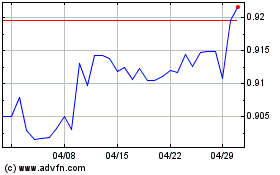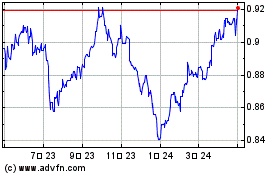Dollar Tumbled Last Week Amidst Rate-peak Hints, Softer Jobs Data
2023年11月6日 - 6:22PM
RTTF2
A dovish Fed and a cooling labor market contributed to the
Dollar's slide in the week ended November 3. The Dollar declined
against the euro, the British pound, the Australian Dollar as well
as the Japanese Yen as markets speculated on an end to the Fed's
tightening cycle, increasing the appetite for riskier
currencies.
Close on the heels of the Fed's monetary policy pronouncements
largely interpreted as dovish, data from the labor market revealed
an unexpected weakness that potentially reduced the Fed's headroom
to keep interest rates at the 22-year high.
Friday's release by the U.S. Bureau of Labor Statistics showed
additions to non-farm payrolls in the month of October falling to
just 150 thousand, versus the previous month's reading of 297
thousand. Markets had expected the count at 180 thousand. The
unemployment rate which was expected to remain steady at 3.8
percent increased to 3.9 percent, the highest since January 2022.
Average Hourly Earnings declined on a year-on-year basis to 4.1
percent, from 4.3 percent recorded in the previous month.
The job-market surprise was seen goading the Fed into a
narrative and action that favors an earlier-than-expected policy
pivot. Bond yields eased in tandem, with the U.S. ten-year yield
falling to 4.576 percent, from 4.845 percent a week earlier. The
reduced borrowing requirement for the fourth quarter also brought
relief to bond markets.
The Dollar Index, a measure of the Dollar's strength against a
basket of 6 currencies tumbled 1.5 percent to 105.02, from 106.56 a
week earlier. The DXY which had jumped to 107.11 before the Fed's
dovish stance was revealed, dropped to as low as 104.94 amidst
widespread relief after seeing the job market update.
The euro gained around 1.6 percent against the greenback during
the week ended November 3, causing the EUR/USD pair to rise to
1.0729, from 1.0564 a week earlier. Fresh hints of an end to the
Fed's tightening cycle reduced the monetary policy divergence with
the European Central Bank which was already bracing for no more
rate hikes in the backdrop of subdued inflation readings. The pair
ranged between a low of 1.0517 recorded on Wednesday and a high of
1.0747 touched on Friday.
The pound surged more than 2 percent against the dollar in week
spanning October 30 to November 3. The GBP/USD pair rose from
1.2122 to 1.2376 over the course of the week. The pair ranged
between a high of 1.2391 and a low of 1.209. The Bank of England
had on Thursday held rates steady at a 15-year high as it tried to
balance the high inflation and odds of a recession.
The AUD/USD pair too jumped 2.81 percent over the past week,
closing at 0.6512 versus 0.6334 a week earlier. Given Australia's
heavy exposure on China, lower-than-expected PMI data from China
weakened the Australian Dollar, dragging the AUD/USD pair to the
week's low of 0.6313 on Tuesday. The pair however jumped to a high
of 0.6520 on Wednesday helped by hawkish rhetoric from Reserve Bank
of Australia officials, as well as dovish hints in the Fed's
stance.
The sharp decline in Australia's trade surplus also led to
speculation about the strong consumer and domestic spending,
renewing fears of rate hikes by the RBA. Data released on Wednesday
showed Australia's exports declining 1.4 percent and imports
jumping 7.5 percent in September.
The Japanese Yen started off on a weak note against the U.S.
dollar as the Bank of Japan's monetary policy announcements
disappointed markets that had expected a more hawkish stance given
the high inflation and a severely weakened yen. The Bank of Japan
kept its key short-term interest rate unchanged at -0.1 percent and
also decided to further increase the flexibility in the conduct of
yield curve control.
The BoJ committed itself to maintaining the target level of
10-year Japanese government bond yields at around zero percent but
said it would conduct the yield curve control with the upper bound
of 1.0 percent for these yields as a reference. The central bank
promised to control the yields mainly through large-scale bond
purchases and nimble market operations and patiently continue with
monetary easing, adding to the yen's weakness.
The developments on the monetary policy front as well as the
disappointing PMI data from China lifted the USD/JPY pair, from the
weekly low of 148.8 on Monday to the week's high of 151.76 on
Tuesday. By the end of the week however, the yen benefitted from
hints of government intervention, the dovish tilt in the Federal
Reserve's stance as well as the cooling in the U.S. job market that
was widely seen as reducing the leeway for the Fed to keep interest
rates at the current highs. The yen edged up against the greenback
and the USD/JPY pair finished the week at 149.37, versus 149.60 a
week earlier.
On the horizon is the Reserve Bank of Australia's interest rate
decision later in the day where it is widely expected to raise
rates by a quarter point. Fed Chair Jerome Powell's speeches on
Wednesday and Thursday as well as ECB Chief Christine Lagarde's
speech on Friday would be keenly anticipated for monetary policy
cues. Trade and inflation readings due from China are also expected
to hold substantial sway over currency markets over the course of
the coming week.
The Dollar Index is currently flat at 105.03. The EUR/USD pair
has increased to 1.0739 whereas the GBP/USD pair has rallied to
1.2392. Ahead of RBA's decision, the AUD/USD pair has dropped to
0.6499. The USD/JPY has increased to 149.79.
US Dollar vs CHF (FX:USDCHF)
FXチャート
から 6 2024 まで 7 2024

US Dollar vs CHF (FX:USDCHF)
FXチャート
から 7 2023 まで 7 2024
